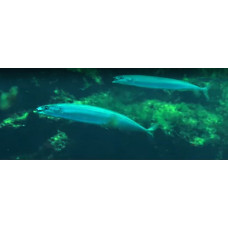Pacific saury (Cololabis saira) is a marine fish of the family Scomberesocidae. Length up to 36 cm, weight up to 200 g. It lives in subtropical and temperate waters of the Pacific Ocean. It is a gregarious pelagic fish. Fattens up in temperate waters in summer and migrates to subtropical waters for wintering in fall. Matures in the 3-4th year of life. Spawning is portioned, from January to June. Fecundity is 9-23 thousand eggs. Planktophage. Commercial fish.
Body elongated spindle-shaped, snout elongated. The scales are small. The lower jaw is slightly longer than the upper jaw. Dorsal fin with 10-11 soft rays shifted to the caudal fin. Anal fin with 12-14 soft rays is located at the level of the dorsal fin. There are 5-6 small adventitious fins behind the dorsal fin and 5-7 such fins behind the anal fin. The caudal fin has a deep notch. The lateral line runs low, along the belly. The back is dark green or blue-green, the sides are silvery. Maximum body length 40 cm, weight 180 g. Lives up to 5-6 years.
Pelagic gregarious fish, habitat depths from 0 to 230 meters. It makes long seasonal migrations: southward to breeding areas in the fall and northward to feeding grounds in the spring. It feeds on zooplankton, mainly crustaceans, fish eggs and larvae.
A gregarious fish that forms large aggregations during certain periods of life. It keeps in the very upper layers of the ocean, usually near the surface of the water, rarely going beyond the ten-meter layer, and, in case of danger, often makes jumps above the water. Only during the wintering period, these fish dive to a depth of about 50 meters. Pacific saury feeds on small animals living in the surface layer of water. For this species is very characterized by seasonal migrations over considerable distances. In the northwestern Pacific Pacific Pacific saury spends the winter in the waters of the warm Kuroshio Current, and after spawning, with the onset of spring, begins to move north for feeding. In summer, it appears near the Kuril Islands and off the coast of eastern Kamchatka, and sometimes enters the Bering Sea. In the northern waters of the Pacific saury fattens up during the entire warm period, and with the beginning of cooling of the waters it moves south again, ending up by the beginning of winter near the southern coast of Japan.
Pacific saury mature at three years of age and spawn annually in the southern part of the Sea of Japan from January to June. Females hatch their small (1.5-2 millimeters in diameter) eggs in batches on hard floating substrate, usually on sargassum algae, but also on any objects in the water. At one of the poles of the oval egg has a bundle of adhesive filaments that serve for attachment. The total number of eggs hatched during the season is 9-23 thousand. During spawning fish are kept sparse flocks, not forming large aggregations. Sexual maturity is reached at the age of 2 years.
Areal - temperate and subtropical zones of the Pacific Ocean in the Northern Hemisphere. Widespread from Korea and Japan along the Kuril Islands and Kamchatka to Alaska and further south to Mexico, 67°-18°N, 137°-108°E. In Russia - in the Sea of Japan, southern part of the Sea of Okhotsk and the Pacific Ocean (near the Kuril Islands).
Pacific saury
Tags: pacific saury


